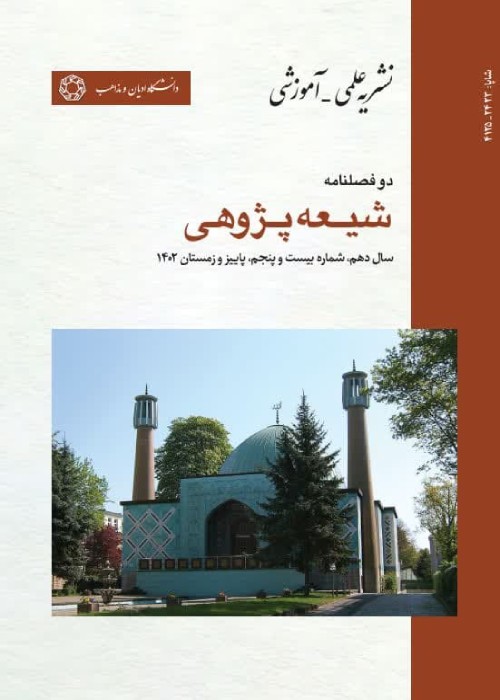فهرست مطالب

فصلنامه شیعه پژوهی
پیاپی 2 (بهار 1394)
- بهای روی جلد: 60,000ريال
- تاریخ انتشار: 1394/02/23
- تعداد عناوین: 6
-
صفحه 5شناخت تفکر شیعی در ایران میان قرن های ششم تا نهم هجری، همچنان نیازمند شناخت بهتر شخصیت ها و آثار شیعیانی است که هدایت جامعه تشیع را در ایران مرکزی، حد فاصل سبزوار، استرآباد، ری، آوه و فراهان، قم و کاشان تا سمنان و دامغان بر عهده داشته اند. یکی از این چهره ها که در دو سه دهه اخیر، اندکی شناخته شده و همچنان، آثار ناشناخته ای دارد، محمد بن حسین رازی آبی (زنده در 630ق) است. وی نویسنده کتاب تبصره العوام است که بیش از نزدیک پنج قرن، به نام شخص دیگری شناخته می شد. از وی آثاری در کلام و فقه یافت و برخی چاپ شده است. محور اصلی مقاله حاضر، مرور آثار و افکار وی است که حلقه ای تازه یافته از افکار شیعی در ایران نیمه اول قرن هفتم است.کلیدواژگان: رازی، میراث قم، تبصره العوام، نزهه الکرام، کفایه الانام
-
صفحه 39یکی از کهن ترین و مهم ترین منابع حدیثی شیعه، در بررسی زندگانی پیامبر(ص)، کتاب کافی نوشته کلینی است. کلینی ذیل «ابواب التاریخ» کافی، در قسمت «مولد النبی(ص)»، از میان انبوه روایات باقی مانده در متون پیشینیان درباره پیامبر(ص)، به چهل روایت بسنده کرده است. در این پژوهش، با بررسی احادیث گردآمده ذیل «مولد النبی(ص)» کافی درصددیم روش، منطق و تاثیر دیدگاه های مطرح عصر کلینی در گزینش روایات این باب را بیابیم. با بررسی سندی و متنی روایات باب «مولد النبی(ص)» نتیجه گرفتیم که هدف و دغدغه اصلی کلینی نه بررسی صرف تاریخی، بلکه نشان دادن ویژگی ها و توانایی های پیامبر(ص) و معرفی مصداقی حجت های الهی بوده است. در خصوص منزلت معصومان(ع)، دسته ای از شیعیان آن روز بر ویژگی های فرابشری و عده ای بر ویژگی های بشری تاکید می کردند؛ اما کلینی روشی میانه برگزید. او ضمن بازتاب دادن دو دیدگاه رایج در این زمینه، به طور ویژه، به جنبه های غیر طبیعی پیامبر(ص) توجه و احادیث بیشتری در تقویت آن گرد آورد.کلیدواژگان: سیره پیامبر(ص)، روش کلینی، کافی، حدیث، مولد النبی(ص)
-
صفحه 55از جمله موضوعات اعتقادی که همه فرق و مذاهب کلامی را به گونه ای، به خود مشغول کرده، امامت است. امامت در نظام اعتقادی شیعه، جایگاه ویژه ای دارد. در این مذهب، بدون توجه به امامت نمی توان به تبیین دیگر آموزه های اعتقادی پرداخت. یکی از ویژگی هایی که امامت شیعه را از امامت دیگر مذاهب ممتاز می کند، علم خاص امام است. علم امام از آغاز پیدایی موضوع امامت، از دغدغه های امامیه بوده است و چنانچه درباره علم امام، اختلافی بین عالمان امامی بوده، به کم و کیف آن مربوط می شود. این جستار در پی تحلیل و بررسی منابع مرتبط با کیفیت علم امام، از نگاه عالمان مدارس قم و بغداد است که با دو رویکرد متفاوت، موضوعات اعتقادی را بررسی کرده اند. در جمع بندی نهایی روشن می شود که پیروان این دو مدرسه کلامی، در این زمینه اختلافی ندارند.
کلیدواژگان: علم امام، متکلمان کوفه، محدثان قم، متکلمان بغداد، متکلمین، محدثین -
صفحه 81حلب، از شهرهای شمالی شامات، در زمان حضور ائمه(ع)، هیچ گاه مرکزی شیعی دانسته نمی شد؛ اما به تدریج، با حضور اسماعیلیه و خاندانهای شیعی و سادات، شیعیان در این مناطق پراکنده شدند. به قدرت رسیدن خاندان آل حمدان برای عالمان شیعی زمینه مناسبی پدیدآورد تا آموزه های شیعی را در این مناطق گسترش دهند. مهاجرت کلینی، نعمانی و سلامه بن محمد به همین دلیل بود. از کوشش های این گروه، تبیین موضوع غیبت و رفع حیرت از جامعه شیعی، در اوایل عصر غیبت کبری بود. کلام امامیان حلب، در این دوره، تحت تاثیر مکتب قم بود. پس از ایشان نیز، با ظهور بزرگانی مانند ابوالصلاح و ابن زهره حلبی، کلام امامیه، در این منطقه، به ویژه در تنازع با اسماعیلیه و دیگر فرق مسلمان شکوفا شد. به اجمال می توان کلام امامیه حلب در نیمه قرن پنجم به بعد را متاثر از مکتب کلامی بغداد دانست.
کلیدواژگان: حلب، تاریخ کلام امامیه، مکاتب کلامی امامیه، ابوالصلاح حلبی، ابن زهره حلبی -
صفحه 107سیره حکومتی حکیمانه علی(ع) منبعی هدایتگر برای همه مصلحان برجای گذاشته است. بخشی از این سیره تعامل با اقلیتهای دینی حاضر در جامعه اسلامی است. شیوه تعامل با اقلیتهای دینی همواره، از مباحث مطرح در جوامع اسلامی بوده است. قرآن خطوط کلی این تعامل را ترسیم و پس از پیامبر(ص) نیز، قرآن ناطق، علی(ع)، نمود عینی و عملی آن را مجسم کرده است. حکومت مقتدر صفویان، نخستین دولت امامی مستقل، با شعار پیروی از سیره ائمه(ع) به عرصه آمد و دو قرن و نیم، بر ایران حکومت کرد. این نوشتار نخست به معرفی چند اصل کلی از سیره علی(ع) در تعامل با اقلیتهای دینی می پردازد و سپس، به شیوه تطبیقی، آن اصول را در سیره حکومتی صفویان بررسی و کاستی ها و نقض آنها را در این حکومت برجسته می کند. وجود تفاوت آشکار بین این دو سیره نتیجه مقایسه آنهاست که عمدتا به دلیل تفاوت در اهداف و نوع نگاه به حکومت بوده است.
کلیدواژگان: اقلیت های دینی، حکومت صفویه، حکومت امام علی(ع)، یهودیان ایران، مسیحیان ایران، زرتشتیان ایران -
صفحه 133پیشینه تشیع در قلمرو ممالیک (648-923ق)، به ویژه در مصر، به صدر اسلام برمی گردد. از دید تاریخ نگاران مصری، در قلمرو ممالیک، تشیع در قرن های نخستین، حتی با وجود سیاست های خشن بنی امیه و بنی العباس علیه شیعیان فراگیر بود. با روی کارآمدن خلافت شیعی فاطمیان، تشیع هرچه بیشتر رشد کرد. با وجود سخت گیری های جانشینان آنان، یعنی ایوبیان، به ویژه صلا ح الدین، تشیع همچنان، تا اوایل عهد حکومت ممالیک، پرطرف دار و فعال بود؛ اما با روی کارآمدن ممالیک و اقداماتشان، در پایان این سلسله اثر چندانی از تشیع باقی نمانده بود. این مقاله به دنبال پاسخ این است که چرا تشیع در قلمرو ممالیک، با وجود سقوط خلافت عباسی به دست مغولان، از رشد و گسترش لازم باز ماند و نتوانست همانند مناطقی چون عراق و ایران گسترش یابد؟ به نظر نفوذ برخی از فقی هان حنبلی و مخالفان سنتی شیعیان در دربار ممالیک، جنگ های طولانی ایلخانان بعضا متشیع با ممالیک، احیای خلافت عباسی در قاهره و... در توقف رشد تشیع تاثیرگذار بوده است. در این مقاله، به بررسی و تحلیل این عوامل خواهیم پرداخت.
کلیدواژگان: ممالیک، تشیع، مصر، ایلخانان، حنابله، بیبرس
-
Page 5Recognition of Shiite thought in Iran in the sixth century AH to the ninth, still need a better understanding of the characters and works of Shiites that have directed the Shiite community in central Iran - Sabzevar, AstarAbad, Ray, Aveh, Farahan, Qom, Kashan, Semnan and Damghan. One of these figures which little is known in the last three decades, and still has unknown works, is Mohammad Ibn Hussein Razi Abi. He is the author of “Tabserat Al-Avam” which over nearly five centuries was known by the name of someone else. Some of his works on theology and jurisprudence have been found and some have been published. The core of the present paper is a review of the works and thoughts of him as a new-found linkage of Shiite thought in the first half of the seventh century.Keywords: Razi Abi, legacy of Qom, Tabserat Al Avam, Nozhat Al Keram, Kefayat Al Anam
-
Page 39One of the oldest and most important of Shiite hadith sources which studies Prophet’s life is Al-Kafi by Kulaini. Kulaini in section “Mawlid al-Nabi” have chosen 40 traditions from the large number of remained traditions. In this study, we are trying to find the method and rhyme of Kulaini in selecting this hadiths; and also to find the influence of Kulaini’s contemporary views on his work. By Textual and Documentary Investigation of “Mawlid al-Nabi” we conclude that the purpose and the main concern of Kulaini was not just historical survey, but to demonstrate the Prophet’s characteristics and capabilities and to present divine Proofs (Hojjat). Kulaini chose the midmost way between two widely held views about dignity of innocents. One view Emphasis on ultra-human characteristics and other one insistence on human characteristics. He paid special attention to unusual aspects of the Prophet and gathered more traditions to strengthen this aspect.Keywords: biography of the Prophet, Methodology of kulaini, Al, Kafi, Mawlid al Nabi
-
Page 55Of the theological issues which have occupied all theological sects, is Imamat. Imamat has special status in Twelver Shiism. Any believe In Shiism related to Imamat and can’t be explained regardless of that. One of the Imamat features that distinguished between the Shia and other sects is the specific knowledge of the Imam. Imam’s knowledge, from the beginning of the emergence of the Imamat, was the Twelvers concerns, and the disagreement between Imimi scholars, was quantitative and qualitative. This article seeks to analyze the resources associated with the quality of the Imam’s knowledge in the thought of Qom and Baghdad’s scholars, which have studied religious topics with deferent approaches. The final conclusion clears that the followers of these two theological schools have no conflict in this issue.Keywords: Imam's knowledge, Qom school, Baghdad school, theologians, Hadith narrators
-
Page 81Aleppo, one of the northern cities of the Levant, was never known as a Shiite center during the presence of Shia Imams, but gradually Ismailis, Shia families and descendants of Prophet were scattered in the area. The rule of Hamdanids prepared an appropriate field for Shia scholars to develop Shia doctrine in these regions. Migration of figures such as Muhammad Ibn Yaqub al-Kulayni, Nu’mani and Salamat Ibn Muhammad was in this regard. One effort of these figures was to explain and resolve the problem of the absence of Imam for Shia community in the early days of “greater occultation”. By this time Aleppo Twelver’s Kalam was influenced by Qom school. Then, with the return of great Imami scholars like Abu Al-salah and Ibn Zohreh of Aleppo, Twelver’s Kalam got flourished in the region, especially in conflict with Ismailia and other Muslim sects. In brief, we can hold Aleppo Twelver’s Kalam after the mid fifth century as influenced by the school of Baghdad.Keywords: Aleppo, Twelver's Kalam schools, greater occultation, Abu Al salah of Aleppo, Ibn Zohreh of Aleppo
-
Page 107Wisely governmental method of Imam Ali is a guiding source for all reformers. Part of this history is the interaction with present religious minorities in Islamic society. The style of interacting with religious minorities has been the proposed issue in Islamic societies. Quran has drawn the main principles of this interaction and Imam Ali, interpreter of Quran, has visualized its practical and objective symbol after the Holy Prophet. Powerful Safavid government, the first independent Shiite government, stepped onto the arena by the slogan of following the Imams’ behavior, and governed Iran for two centuries and 50 years. This paper firstly introduces some generalities of procedure of Imam Ali in interacting with religious minorities and then, comparatively, investigates these generalities in the history of Safavid rulers and shows their weakness in their operations. The results show that there is obvious difference between these two governments which is due to the difference in the purposes and views about government.Keywords: religious minorities, Safavid rulers, Imam Ali's government, Iranian Jewish, Iranian Christian, Iranian Zoroaster
-
Page 133Background of Shi’ism in Sirya and Egypt can be traced to the earliest Islam. Egyptian historians such as Maghrizi and Ibn Taghriberdi believed Siite Islam was present and active in the early centuries in the mentioned areas. The severe and harsh policies of Sunni rules such as Ummayads, Abbasids and, in particular, Ayyubids couldn’t reduce their great role. But because of the Mamalik activities against the Shiites; their number decreased extremely at the end of Mamalik era, according to Egyptian contemporary historian. This article studies the question “why Shiism could not progress after the downfall of Abbasids Caliphate”.It seems that influence of some Hanabalite scholars in Mamalik court, the long hostility between Mamalik and Iran Ilkhanids in Iran and finally Caliphate revival in Cairo by Baybars had important role in this regard.Keywords: Shiism, Mamalik, Hanabites, Egypt, Ilkhanids, Baybars


